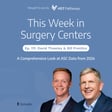Become a Creator today!Start creating today - Share your story with the world!
Start for free
00:00:00
00:00:01

Matt Lau – Annual Budget Planning: 4-Step Process
Matt Lau, Senior Vice President of Client Accounting & Financial Services at MedHQ, has been helping ASCs manage their financials for over 20 years. With more than 400 budgets under his belt, Matt has developed a simple, no-nonsense, 4-step process for creating budgets that actually work. In today’s episode, we’ll break down those four steps and hear some great stories and insights from Matt along the way. Whether you’re new to budgeting or just looking to streamline your approach or hear how others do it, this conversation is packed with really great advice.
If you’re looking for more advice on Annual Budget Planning:
- Check out last week’s episode on Knowing Your Audience with Suzi Walton and Matt Cavanagh
- Watch MedHQ’s webinar on Navigating ASC Budgeting with Matt Lau
Brought to you by HST Pathways.
Transcript
Podcast Introduction
00:00:01
Speaker
Welcome to This Week in Surgery Centers. If you're in the ASC industry, then you're in the right place. Every week, we'll start the episode off by sharing an interesting conversation we had with our featured guests, and then we'll close the episode by recapping the latest news impacting surgery centers. We're excited to share with you what we have, so let's get started and see what the industry's been up to.
00:00:28
Speaker
Hi, everyone. Here's what you can expect on today's episode.
Guest Introduction: Matt Lau
00:00:31
Speaker
Matt Lau is the Senior Vice President of Client Accounting and Financial Services at MedHQ, and he has been helping ASCs manage their financials for over 20 years. With more than 400 budgets under his belt, Matt has developed a simple, no-nonsense, four-step process for creating budgets that actually work.
00:00:52
Speaker
So in today's episode, we'll break down those four steps and hear some great stories and insights from Matt along the way. And whether you're new to budgeting or just looking to streamline your approach or just hear how others do it, this conversation is packed with some really great advice.
Episode Format Change
00:01:09
Speaker
Now, typically after my conversation with our guests, I'd switched to our data or news segment, but since my time with Matt was so thorough, we're actually going to skip an additional segment and I will pick up again with the news next week. Hope everyone enjoys the episode and here's what's going on this week in surgery centers.
00:01:30
Speaker
Hi, Matt. Welcome to the podcast. Hey Erica. Thank you very much. Appreciate it. Can you please share a little bit about yourself and your ASC experience with our listeners?
Matt Lau's Career Journey in ASC
00:01:41
Speaker
Sure. So I've been in the ASC world for almost 20 years now. And most of that time I spent at Region Surgical Health, I spent 16 years there, worked my way up from financial analyst to senior financial analyst to director, to controller, and to ah ultimately to CFO. And throughout all those years, we
00:02:06
Speaker
oversaw, created a template and a process around budgeting for all of the ASCs that we owned and managed. And that experience has carried over to my current job as a senior VP of client financial and accounting services at MedHQ. So I've been in the ASC world on a financial side and doing a lot of budgets every year.
00:02:33
Speaker
for, again, nearly 20 years. and And they've gotten pretty good at it and and have a pretty good sense of process and what the SCU is going to work with and when it gets a little bit too complicated. So I think I've finally found a good landing zone for a good process every year for our SCU. Very cool. If you had to guess, how many budgets do you think you've done? So if you do just do quick math, say 20 a year,
00:03:02
Speaker
for almost 20 years. So all right so that's 400 right there. Wow. Very cool. So we are very lucky to have you on our series then. So last week we did an episode about the importance of knowing your audience before you sit down and start putting that budget together.
Benefits of Annual Budgeting Process
00:03:21
Speaker
So today we're going to take it a step further. As you mentioned, you have this four part process that you've seen success with. So I'd love to share that with our listeners. But first, what are the benefits of having that repeatable annual process?
00:03:36
Speaker
Well, it's like anything else. If you do something for the first time, it's probably not going to go super smooth. There's going to be bumps and pauses and hurdles in the way. But if you have a process that you you stick by, it the same beginning, the same middle part, the same end,
00:03:58
Speaker
the next year it's gonna be a lot easier. And and the year after that's gonna be even easier than that. It's almost like a recipe. You make it for the first time, maybe it's okay, but then you start, you get familiar with it, you know what to do and when to add and when to preheat and stuff like that. And after a while you get so good at it, you start, oh, I can make a little tweak here and I can even get even better at it.
00:04:25
Speaker
The more you do it, the more you rely on that sort of home area, sweet spot of the budget process, the better you'll get at it and the more you'll be able to get out of it year after year. And instead of taking months and months of budget process where you just dreaded, maybe you could get that process down to to only a few weeks and it produces something that you really look forward to you and it's meaningful going into the new year.
00:04:54
Speaker
Yep. That makes a ton of sense. Okay. So let's get into the process itself. Where do we start? What is step one?
First Budgeting Step: Creating a Business Narrative
00:05:01
Speaker
Well, step one, I'm taking the stuff back because you had mentioned know your audience. um my my My experience with all those 400 plus budgets that I've done over the years is that most of the time my audience, the person who I'm working with closest is the ASC administrator.
00:05:22
Speaker
And the ASC administrator, super smart person, knows their business inside and out. Most of the time, my my experience has shown me that person has a clinical background, not necessarily a numbers or accounting or a business background.
00:05:41
Speaker
And so it's not that they don't know and understand the business side of it. It's just that their sweet spot, their comfort zone is the clinical side. So what I want to do is I want to take take the the numbers, all the numbers of budget equals numbers and all the line items of thousands of numbers on a page. I want to be able to simplify that. And so the the best way from a process standpoint that I like to simplify that is to take a step back.
00:06:10
Speaker
Don't go jumping into the numbers right away. Take a step back and think, okay, what do I really want to do for the next year? And really creating a mini business plan for what your vision is for your ASC in the upcoming year is really the first step in the budgeting process. Don't even worry about the numbers, but just story, narrative, tell me what you want to do.
00:06:38
Speaker
And sometimes that can be difficult. So, so there are some tips and structures around trying to getting you to think about what you can do in the next year can, they can help you get started. And one of those that I like to to think about is a SWOT analysis and that's start, that's stands for strengths, weaknesses, opportunities, threats, and you just look internally and go, okay, what are our businesses strengths and weaknesses inside the walls of your facility? And then, and also you look external and you think, what are the opportunities in the market? And where are the threats in the market? And you you put a list together of all of those things, strengths, weaknesses, opportunities, and threats. And you think, okay, well, what do we do? How do we maximize our strengths?
00:07:28
Speaker
How do we take advantage and really go after our opportunities? How do we minimize our weaknesses and how do we mitigate
SWOT Analysis for Planning
00:07:36
Speaker
the threats? And that process, that sort of technique can really yield a good sense of what you want to do for the upcoming year, your one-year plan. Maybe you're doing a three-year plan, but that qualitative, that story that you want to tell of what our expectations are,
00:07:58
Speaker
What we want to do in the next year is really the first step in my mind in in the budget process, and it doesn't have anything to do with the numbers. Yeah, I think that's great because I personally am not super analytical. So the idea of starting with a spreadsheet is very intimidating to me. I will procrastinate for as long as I possibly can. yeah But if someone gives me a blank piece of paper and I could sit down and do a brain dump of all these ideas and problems we've seen and how can we solve them, that to me is much more enticing to start with than than the spreadsheet.
00:08:31
Speaker
Right. Yeah. And really, you're going to get a better, you're going to get a better sense of what you want to do rather than by starting at the top level than if you start building up. Oh, what do I think my office supplies expense is going to be next year? Well, wait a minute. Don't you have to do five more things before that, before you figure out what you're going to be spending on paper?
00:08:54
Speaker
and and toner and stuff like that. So rather than getting into the weeds right away, it's starting at that top level and really getting a better, good sense of what you want to do in the upcoming year. Love it. Okay.
Analyzing Case Volumes
00:09:07
Speaker
the the And now once you have that story, once you have that narrative, once you have that good idea of what you want to do in the upcoming year, the second step is I want to focus you, I would suggest focusing the administrator on what's the driver of the business itself. And every ASC, this is true. Your case volumes, types of cases you're doing, that is the driver of your business. And so again, you're starting to think of numbers here, but it's really the first thing that any administrator is going to look at a month to month basis, maybe even a day to day basis in terms of scheduling.
00:09:48
Speaker
is what's our case volumes today? What's our case volumes this week? but's sorry What was our case volumes last month? That is driving almost the entire financial performance of the entire company. Case volumes are going to drive revenue. They're going to drive supply costs. They're going to drive labor costs. Those are the biggest line items on your financial statement every month, every quarter, every year. And they're all driven by the same thing.
00:10:18
Speaker
case volumes. So I always ask the administrators that I work with is talk to your doc, show them, okay, Dr. Smith, you did 120 cases over the last 12 months. Do you think you're going to do more next year? And you do that with every single one of your docs so that you have a really great sense of, okay, here's what we think is going to happen in terms of volumes and volume change compared to the previous year. And then you augment that with the story that you created in the first step. It's, oh yeah, part of the story, part of the plan for the next year, it's also to recruit three new doctors. And we're going to recruit the first one in January. He or she will start in January. We'll have another one in by May, and then the last one will come till September. But
00:11:15
Speaker
Volumes really drive the overall business. And so if you get a good sense by doc and have those discussions by doc, you're going to have a really great sense of what's going to drive your overall business and really an idea of timing of when cases will come in, maybe when code cases will leave vacation. i win When is Dr. Smith going to go to the Bahamas? Is it going to be June or is it going to be July this year?
00:11:42
Speaker
a good sense of all that and it's all because you're focusing on the one thing that drives the overall business volumes and the types of cases that are being done. If you focus on that, it's going to drive your broad budget process as well.
00:11:57
Speaker
Yeah. And in addition to those conversations you have with your docs, are there any other kind of metrics you would suggest people look at to support that conversation? So like block utilization, obviously historical case volume, but yeah, like block utilization, special, anything else that you would recommend they pull? It's a great opportunity to revisit things like block utilization on time starts.
00:12:23
Speaker
that sort of thing and you start getting into the weeds a little bit. But from an operational standpoint, if Dr. Smith knows that he or she is going to do 30% fewer cases this year or or next year than they did this year, then you go, okay, well, you know what? Let's take a look at your block utilization. Let's take a look at our time starts and do you need every other Monday at seven o'clock Or if your volumes are are expected to go down, maybe we just do one Monday or every third Monday or so something like that. And you can start massaging your scheduling and maybe somebody else is going to pick up that volume. And you you start racially thinking about how those volumes are going to take place. Who's going to be on on the kind of the the slide from a volume perspective, who's going to be picking up from a volume perspective. And then you can plan around that.
00:13:21
Speaker
But it really starts with those discussions with your docs. Yeah. And one one more follow-up question. do you um When you do your budgets, do you like to be um more on so on the conservative end? So let's say a doctor says, yes, I'm going to increase by 10%. Are we putting in 8%? Or what is your suggestion suggestions there? Generally speaking, I think docs may have the may lean on the side of more aggressive from a numbers perspective. They'll think about their best month they've ever had and say, oh, I did 35 total joints that that month. I'll do 40 every month for for the entire next year. And so you have to balance input from the dog with historical kind of reality check. And I always hate to over promise and under deliver,
00:14:18
Speaker
on budgets, on projections, on anything really. So so balancing and and having that that that discussion with your docs got to be part of that. Like, all right, really, Dr. Smith, are are you really going to be doing your best month every month? Or I'll tell you what, you come you'd come back at them and say, here's what the data shows. You averaged 20 cases per month last month last year.
00:14:46
Speaker
Does that seem right? Why would you think it's going to go up by 50%? And if there's a good reason, great. But I always like to balance reality with, hey, if you want to stretch, you want to be aggressive, that's great. But we want to rely on these numbers as a guide for next year. And having a stretch budget is fine, but I'd rather have a more accurate depiction of of what we're going to do next year than a pie in the sky. Because oftentimes, if you have too much of a stretch, it becomes almost a disincentive. I'd rather have something that's more accurate or even leans to the conservative side. now I'm an accountant by nature, so I suppose most accountants are probably more conservative than anything else, but I'd really rather have more realistic than aggressive. Perfect. That makes a lot of sense. All right, so we have step one, the narrative. Step two, we're doing an in-depth case volume analysis. What is step three?
Financial Projections
00:15:46
Speaker
Top three is, all right, you've got your big picture of what you want for next year. You've got your volumes that are going to drive your business. Now it's time to marry the volumes to how are we going to convert those volumes into dollars? And so you want to take a look at what are you averaging from a reimbursement per case on average, buy for each docket if possible.
00:16:13
Speaker
So Dr. Smith averages $2,000 per case in terms of collections to the center. We're projecting 120 cases. Great. Let's 120 times 2000 per case equals 240. And just extend that when you do that for all of your docs. Now, what you also want to do is just don't assume that your peer makes this going to remain consistent.
00:16:40
Speaker
And your contracts are going to be you making, so if you know that those numbers are going to change. Well, we did recruit some new docs, but their patient mix, their practice is mostly Medicare. And Medicare is going to reimburse less than our payer contracts. Well, then you're going to have to determine what their ads reimbursement is going to be based on those inputs, that those data inputs. and payer mix ah is a big part of that. But using history as an example, if we don't think anything is going to change much in terms of Dr. Smith's payer mix,
00:17:20
Speaker
and we know our contracts are locked in, then you can be reasonably certain that what you've been collecting on Dr. Smith's cases on average is probably what you're going to in the upcoming 12 months. And so you could use that number, but don't just blindly put that in as, okay, we're going to keep reimbursing the exact same right. You have to do some thinking and critical thinking around, okay, hey is our payments going to change? Is our contracts going to change?
00:17:49
Speaker
and And go from there and if they're not great, but if they are, you have to kind of hear that into what we think is going to be our average reimbursement per case for Dr. Smith's cases going forward. And you do the same thing for all your other dogs. You do the same thing, by the way, with your at average supply costs per case, even labor per case. If you've got that history, then you say, well, I know in the number of cases. I know how much on average it costs.
00:18:17
Speaker
on in terms of li supplies and implants and pharmacy, and even again, even labor, say cost per case times the number of cases equals what our expense is going to be in our budget for that particular type of expense. And so those historical averages, specifically on on the more recent in the last 12 months of of averages,
00:18:42
Speaker
You use those per case cost averages or the per case revenue averages multiplied by the number of cases. And now you've got your annual budget for those revenue items and expense items. And it really is that simple. If you know your average cost per case, your average revenue per case, and you have your number of cases, A times B equals C and you just drop it right into your budget and you're off and running.
00:19:11
Speaker
Perfect segue. Spreadsheet time. Step number four. You make it sound so easy with those three metrics, but what's, all right, so you have triangulated, you've gotten there. Now it's time for our line items and the spreadsheet. What does that part look like?
Compiling Financial Data
00:19:28
Speaker
So it really, the way I do this is I start with your financials, take your popular law statement, your income statement from the last 12 months.
00:19:38
Speaker
you layer in your volumes at the top, and then right next to total for your 12 month numbers, you go, okay, I'm going to take my total revenues, divide them by my total case volumes to get a average revenue per case. I do that with every single line item on your income statement. Some costs, and not everybody does this, but what I like to do is I like to split your expenses into a variable section and a fixed section. The variable section, variable types of costs are going to go up with the number of cases. If the number of cases go up, your variable expenses will go up. If your cases go down, your variable costs will go down. And so those types of costs, your supply costs, implant costs, labor costs, the more cases you do, the more expenses you're going to have in those categories.
00:20:35
Speaker
And so I calculate basically what have we been doing over the last 12 months, revenue per case, supply costs per case, labor per case, and any other variable costs that you could think of per case and say, Oh, now I've got these multipliers. I know what our actual history has been recent history. And when I layer in.
00:20:59
Speaker
Those inputs from user are updated volumes, volume expectations by doc for the next year. I could just multiply those out right on the spreadsheet, right next to what our actual history was and our actual history on average per case is. And then, and and then just extend it out. Here's what's based on volume expectations. Here's what our revenues are going to be.
00:21:24
Speaker
if based on this particular revenue per case. Here's what our supply costs are going to be based on this supply cost per case and move it out that way. For your fixed expenses, rent, utilities, bank charges, maybe some liability and insurance, that sort of thing, you just say, well, those fixed costs are basically costs that are not going to change regardless of what the volumes do.
00:21:52
Speaker
So it doesn't matter if you do zero cases or a hundred cases or a thousand cases in a month, your rent is going to stay the same. So you don't want to do a rent rent cost per case for that, but you'd want to know what your average monthly cost is going to be for those fixed expenses and say, okay, the average monthly times 12. Do we think there's going to be an inflation factor?
00:22:17
Speaker
apply that and boom, you are done. So, so you've done all the heavy lifting. You've done the big picture. You've done, you've gotten a good sense by talking to your docs about the driver, the types and volume of those cases, your plot, your plot, what on the reimbursement side to any changes on the top line. And then you're using the spreadsheet or kind of averages over to the last 12 months.
00:22:45
Speaker
to extend out what you're going to be doing on all your other expenses. And when you're done, what you should have and you total it all up, what you should have is a numerical story, a budget that basically matches up with the first step that you you took. And that's, what do we want to do for the next year? What is that big picture? What is that plan for the following year?
00:23:12
Speaker
Well, there's the narrative, the story that we came up with in the first part of this process match the numbers that we came up with in the end of the process. And if it does, and they make sense, that's a budget that you can take to your board and tell the story behind and really get their approval and and off you go.
00:23:32
Speaker
Yeah, no, I think that's a wealth of knowledge of exactly how to get there. So we have all of our steps, you have the story and I love that we have the story because when you are presenting it at a board meeting or or wherever it is, you can back it up how we exactly how we got to these numbers and why they're important and again, tell that story. So I think going through that process would make people feel a lot more comfortable presenting it as well, knowing how they got there.
00:24:01
Speaker
Yeah, and what I found at board meetings is your board members, the physician board, and maybe if you're at a JV, at a hospital board, they don't want to know, they don't want you to go through every single line item on the budget. They want a high level level story and numbers that correspond to it, but very high level that you can summarize and present in five, 10 minutes. And give them the detailed stuff first.
00:24:31
Speaker
But during the board meeting, keep it to succinct, keep it to a type 10. And your board will appreciate it. they Their eyes won't spin and go into the back of their head like probably those administrators do at the beginning of the process. You have that type 10 that includes the story behind the numbers and then just a high level of the numbers. It's a much easier presentation and approval process at the board. Perfect. Love it.
00:25:02
Speaker
All right, Matt, final question. We do this every week with our guests. What is one thing our listeners can do this week to improve their surgery centers?
Advice on Labor Cost Management
00:25:12
Speaker
That's a great question. The one thing that always pops out to me, and again, accounting financial analysts going way back, the one thing that always pops out to me when I look at somebody's financial statements, the ASC's financial statements, the labor line,
00:25:29
Speaker
is almost always, is it's one of the two largest expense line items for every DSC that I've ever seen. And how do we control, get a better handle around our labor costs? And one of the things that they I learned over the years, and again, I'm not super into operations, but operations and finance talk to each other a lot. And one of the things that I thought, it's super simple, it works.
00:25:59
Speaker
is just on a weekly basis do simple staff planning. And what I mean by that is take your schedule of cases for, we get to Friday, take your schedule of cases that you have on the books for the following week and compare that to your staffing schedule for the following week, day by day. And when you just line those two up,
00:26:26
Speaker
Okay, Monday case volume schedule versus Monday staff schedule. Friday, next Friday case volume schedule versus staffing schedule. You'll be able to see what days are we light on cases. Do we need to to bring in a full clinical team for that day? to Do we think about potentially canceling the the the one or two cases that they are moving into Thursday?
00:26:54
Speaker
and not not even have the clinical staff of come in on Friday. um If we're going to be done by noon, can we send folks home early? Oh, we're going to be super, super busy on Tuesday. Maybe we need to bring additional teams in that day. But that simple process of mirroring up and matching up your surgery schedule for the following week to your staff schedule for the following week, day by day,
00:27:23
Speaker
That simple comparison on a Friday, the Friday proceeding that week makes a huge difference in your labor efficiency. And it could really turn into a lot of ah dollar savings on your labor line item. When you take that weekly process and extend it out a month, three months, six months, a year, and you could really see how that one simple thing can yield to significant cost savings long term.
00:27:53
Speaker
All right. That is great advice. Thank you so much, and thanks for coming on today. I appreciate it. Thank you. everyone



















